lordroel
Administrator
Posts: 67,964 
Likes: 49,369
|
Post by lordroel on Jun 25, 2019 2:52:53 GMT
Slovenian Independence War of 1991 in real time
  The Slovenian Independence War (slovenska osamosvojitvena vojna) ore also known as the Ten-Day War (Slovene: desetdnevna vojna) was a consequence of the Slovenian tendencies towards decentralisation and democratisation. Slovenia's proposal of a different arrangement of existing relations was rejected. Pressures towards a Greater Serbia, first in Kosovo and then, threateningly in other parts of Yugoslavia caused that a large majority of the Slovene electorate voted for a sovereign, independent state in the December 1990 referendum. After multi-party elections in Slovenia in April 1990, the Yugoslav People's Army YPA) began preparations for an armed response to democratic changes in Slovenia and Croatia by confiscating the majority of Territorial Defence (TD) forces' weaponry. The disintegration of Yugoslavia was greatly enhanced by the promotion of Greater Serbia with Slobodan Milosevic at its head. The suppression of those who disagreed had its supporters among even the highest ranks of the YPA, even though many officers believed for a long time that preparations to "settle accounts" were aimed at defending the Yugoslav idea of the equality of all peoples. Slovenia, on its part, was also preparing for a declaration of independence by providing reinforcement to the Slovenian TD and police forces. On 28 September 1990, a constitutional amendment was adopted which stipulated that in peace and emergencies, the command of TD was to be transferred to the Presidency of the Republic of Slovenia. The Presidency, with Milan Kucan as its President at that time and during the war, immediately appointed a new TD National Command under the command of Janez Slapar. On March 18th, as tensions increased, the RS Presidency established a Contingency Operational Coordination Staff co-chaired by Igor Bavcar and Janez Jansa. It was tasked with the coordination of security and defence preparations and in wartime, the tasks of the staff of the commander-in-chief. The main Slovenian armed components at that time were the Territorial Defence and police forces. Civil defence forces, the criminal investigation agency and VIS ?? had the important mission of protecting human lives and property. Slovenian defence tactics were based on an April 1991 document that dealt with possible dissolution from a defence perspective. In case of an armed YPA attack the plan was to block all of the units and barracks in Slovenia, to stop any advances from Croatia made by the YPA and to resist actively wherever Slovenian defence forces had the military advantage. The first location chosen by the YPA to settle accounts with Slovenia was Maribor, where on May 23rd, it provoked an incident in order to attack a TD training centre. The YPA even kidnapped the Slovenian negotiator, Lieutenant Colonel Vladimir Milosevic. In addition, the first Slovenian fatality, Josef Simcik from Miklavz, was run down and killed by a military APC. The resolute response of the Centre personnel and the inhabitants of Maribor spoilt the YPA's plans. On June 25th, a constitutional law on independence was adopted by the Slovenian Assembly. Yugoslav signs and flags at border crossings were replaced with Slovenian ones, and border crossings with Croatia set up. The evening of the same day, the Federal Executive Council convened in Belgrade. It issued a decree for the protection of the national borders in Slovenia, which gave the YPA and federal police forces the green light for an armed attack on Slovenia. The approach of the military and police forces was focused in the first phase on the Slovenian borders and the Brnik airfield. If Slovenia was cut off from the outside world in the first phase, "getting even" with those in Slovenia who were in favour of independence by replacing them with new people who would be puppets in the implementation of the Serbian goals would follow in the second phase. Photo: "Slovenia is independent!" reads the banner headline of the Delo daily on June 25th 1991
 Map of the Slovenian Independence War Map of the Slovenian Independence War

|
|
stevep
Fleet admiral
Posts: 24,832 
Likes: 13,222
|
Post by stevep on Jun 25, 2019 11:59:35 GMT
Lordroel Interesting. I vaguely remember Slovenia becoming independent but wasn't really aware of fighting occurring. Thought it had largely escaped without fighting possibly because with Croatia in the way the Serbs had higher priorities. Have to see what develops. 
Steve
|
|
lordroel
Administrator
Posts: 67,964 
Likes: 49,369
|
Post by lordroel on Jun 25, 2019 13:20:30 GMT
Lordroel Interesting. I vaguely remember Slovenia becoming independent but wasn't really aware of fighting occurring. Thought it had largely escaped without fighting possibly because with Croatia in the way the Serbs had higher priorities. Have to see what develops.  Steve
It was the beginning of the Yugoslav Wars, and the only one that lasted no more than 10 days compared to the Croatian War of Independence and the Bosnian War wich lasted 4 years. If you want to read more, check this page, press on Se strinjam and you will download a PDF called DEFENDING DEMOCRATIC SLOVENIA 1991, a very interesting read about the 10 day war. |
|
stevep
Fleet admiral
Posts: 24,832 
Likes: 13,222
|
Post by stevep on Jun 25, 2019 14:32:07 GMT
Lordroel Interesting. I vaguely remember Slovenia becoming independent but wasn't really aware of fighting occurring. Thought it had largely escaped without fighting possibly because with Croatia in the way the Serbs had higher priorities. Have to see what develops.  Steve
It was the beginning of the Yugoslav Wars, and the only one that lasted no more than 10 days compared to the Croatian War of Independence and the Bosnian War wich lasted 4 years. If you want to read more, check this page, press on Se strinjam and you will download a PDF called DEFENDING DEMOCRATIC SLOVENIA 1991, a very interesting read about the 10 day war.
Lordroel
Thanks for that. Had a quick read through and very interesting although obviously a little partial and showed that tensions and some conflict had been occurring for a couple of years, along with a lot of preparations, markedly more efficiently it appears on the Slovenian side.
Steve
|
|
lordroel
Administrator
Posts: 67,964 
Likes: 49,369
|
Post by lordroel on Jun 25, 2019 14:42:31 GMT
It was the beginning of the Yugoslav Wars, and the only one that lasted no more than 10 days compared to the Croatian War of Independence and the Bosnian War wich lasted 4 years. If you want to read more, check this page, press on Se strinjam and you will download a PDF called DEFENDING DEMOCRATIC SLOVENIA 1991, a very interesting read about the 10 day war. Lordroel Thanks for that. Had a quick read through and very interesting although obviously a little partial and showed that tensions and some conflict had been occurring for a couple of years, along with a lot of preparations, markedly more efficiently it appears on the Slovenian side.
Steve
Well of course it is a little partial, its written by Slovina wtitters, but its still a nice thing to read if you want to know more about this war than only reading the Slovenian Independence War Wikipedia page |
|
lordroel
Administrator
Posts: 67,964 
Likes: 49,369
|
Post by lordroel on Jun 26, 2019 3:07:30 GMT
The day before the war, June 26th 1991
On the morning of June 26th, units belonging to Yugoslav People's Army's 13th Corps left their barracks in Rijeka, Croatia, to move towards Slovenia's borders with Italy. The move immediately led to a strong reaction from local Slovenians, who organized spontaneous barricades and demonstrations against the YPA's actions. There had been no fighting yet, and both sides appeared to have an unofficial policy of not being the first to open fire. Photo: Slovenian troops placing hedgehog-Czech barricades on a bridge across the River Dragonja
 By this time, the Slovenian government had already put into action its plan to seize control of the republic's border posts and the international airport at Brnik. The personnel manning the border posts were, in most cases, already Slovenians, so the Slovenian take-over mostly simply amounted to changing of uniforms and insignia, without any fighting. This was undertaken, in the words of Janez Janša, to "establish our sovereignty in the key triangle, border-customs-air control." It also had important practical effects. The border crossings were a major source of revenue. In addition, by taking control of the borders, the Slovenians were able to establish defensive positions against an expected YPA attack. This meant that the YPA would have to fire the first shot. YouTube (Slovenia declares independence)
|
|
lordroel
Administrator
Posts: 67,964 
Likes: 49,369
|
Post by lordroel on Jun 27, 2019 2:52:42 GMT
Day 1 of the Slovenian Independence War, June 27th 1991
On the morning of June 27th, the first day of the war more YPA troop movements took place. A unit of the YPA's 306th Anti-Aircraft Regiment, based in Karlovac, Croatia, crossed the Slovenian border at Metlika. A few hours later, a column of tanks and armoured personnel carriers of the YPA 1st Armoured Brigade left their barracks at Vrhnika near the Slovenian capital Ljubljana, heading for the airport at Brnik. They arrived a few hours later and took control of the facilities. As the YPA was the federal army, its forces were customarily deployed in various places within the federal republics including Slovenia. To the east, YPA units left Maribor heading for the nearby border crossing at Šentilj and the border town of Dravograd further west. The Yugoslav Air Force aircraft dropped leaflets over various parts of Slovenia bearing the messages "We invite you to peace and cooperation!" and "All resistance will be crushed." Photo: a unit of the YPA 306th Anti-aircraft Regiment, based in Karlovac, Croatia on a road in Slovenia.
 YouTube clip YouTube clip
Photo: YPA tanks in the streets of the Slovenian city of Maribor.
 The Slovenian leadership was told of the movements of the YPA in the early hours. The military leadership of the Fifth Military District, which included Slovenia, was in telephone contact with Slovenian president Milan Kučan, telling him that the troops' mission was limited to taking over the border crossings and airport. A meeting of the Slovene presidency was hastily convened at which Kučan and the rest of the members decided on armed resistance. The Slovenian government had received warnings that the YPA would use helicopters to ferry special forces troops to strategic locations. It issued a warning to the YPA's 5th Military Command District in Zagreb that if helicopters continued to be used they would be shot down. The warning was disregarded by the YPA leadership, which still believed that the Slovenians would back down rather than fight. This was, however, a disastrous miscalculation. In the afternoon of June 27th, the Slovenian TO (Slovenian Territorial Defence) shot down two YPA helicopters with SA-7 missiles, one of them a Gazelle over Rožna Dolina, Ljubljana, killing the occupants (one of whom, Toni Mrlak, was a Slovenian pilot, as the YPA's forces consisted of nationals from all the republics). The Slovenian Territorial Defence also took up positions around YPA barracks in various locations, effectively besieging them, and launched a series of attacks on YPA forces across Slovenia. At Brnik, a Slovenian TO unit attacked the YPA troops holding the airport, and at Trzin a firefight developed in which four YPA soldiers and one Slovenian TO soldier (Edvard Peperko) were killed and the remainder of the YPA unit was forced to surrender. Attacks were also launched by Slovenian TO units on YPA tank columns at Pesnica, Ormož and Koseze near Ilirska Bistrica. A tank column from the YPA's 32nd Mechanised Brigade, advancing from Varaždin in Croatia, was blocked at Ormož near the Slovenian border and found itself unable to break through a Slovenian barricade. Despite the confusion and fighting, the YPA nonetheless successfully accomplished much of its military mission. By midnight on June 27th it had captured all of the crossings along the Italian border, all but three crossings on the Austrian border and several of the new crossing points established along Slovenia's border with Croatia. However, many of its units were still stuck in vulnerable positions across Slovenia. Photo: The international border crossing Vrtojba between Yugoslavia and Italy.
 Photo: a YPA tank column at the Vrtojba border crossing. Photo: a YPA tank column at the Vrtojba border crossing.
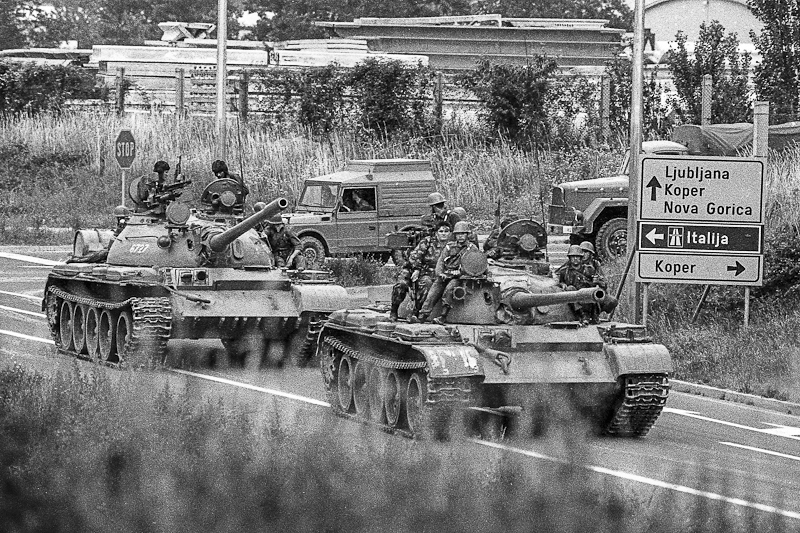 Photo: a tank belonging to the YPA at Vrtojba a border crossing point between Yugoslavia and Italy. Photo: a tank belonging to the YPA at Vrtojba a border crossing point between Yugoslavia and Italy.
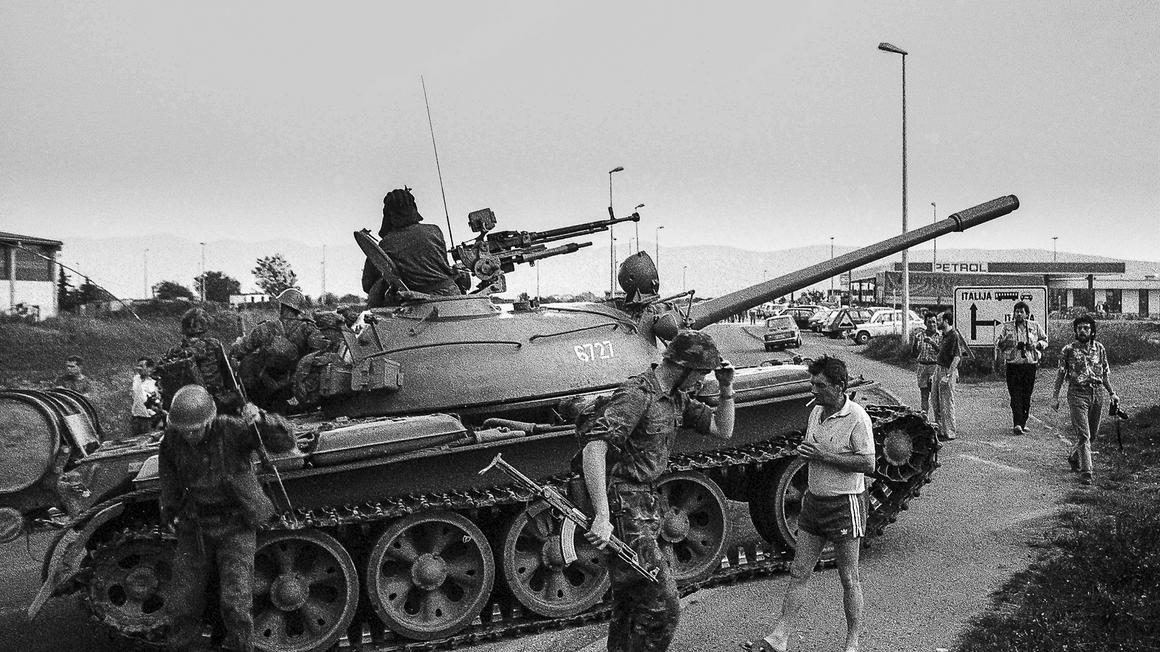 Photo: A YPA soldier soldier asks three Slovenian militiamen to withdraw from Vrtojba a border crossing point between Yugoslavia and Italy. Photo: A YPA soldier soldier asks three Slovenian militiamen to withdraw from Vrtojba a border crossing point between Yugoslavia and Italy.

|
|
lordroel
Administrator
Posts: 67,964 
Likes: 49,369
|
Post by lordroel on Jun 28, 2019 7:56:46 GMT
Day 2 of the Slovenian Independence War, June 28th 1991
During the night of June 27th–28th, Slovenian TO units were ordered to undertake a general offensive against the YPA. The Slovenian defence ministry ordered: At all locations where RS (Republic of Slovenia) armed forces (Slovenian Territorial Defence) have the tactical advantage, offensive actions against enemy units and facilities will be carried out. The enemy will be summoned to surrender, the shortest deadline possible for surrender given and action taken using all available weapons. While in action, any necessary arrangements will be made to evacuate and protect the civilians.
Additional fighting took place throughout the day. The YPA tank column that had been attacked at Pesnica the previous day was blocked by impromptu barricades of Slovenian trucks at Štrihovec, a few miles short of the border with Austria, where it again came under attack by Slovenian TO personnel and Slovenian police. The SFR Yugoslav Air Force mounted two airstrikes in support of the YPA forces at Strihovec, killing four truck drivers. At Medvedjek in central Slovenia, another YPA tank column came under attack at a truck barricade, where air raids killed six truck drivers. Heavy fighting broke out at Nova Gorica on the border with Italy, where the Slovenian Special Forces fired two armburst antitank rockets and fired 700 rounds from infantry weapons. Slovene troops destroyed two YPA T-55 tanks and captured an additional three, plus a BTS-1 racked buldozer. Three YPA soldiers were killed and 16 wounded, among them the commander of the armored column and 98 surrendered. A number of wounded were admitted to Gorizia's hospital after crossing the Italian border. Photo: Soldiers and citizens before the clash in Rozna Dolina border crossing near Nova Gorica.
 YouTube (clash in Rozna Dolina border crossing near Nova Gorica) YouTube (clash in Rozna Dolina border crossing near Nova Gorica)
Photo: A YPA tank is hit by a Slovenian TO fired armbrust at the Rozna Dolina border crossing near Nova Gorica.
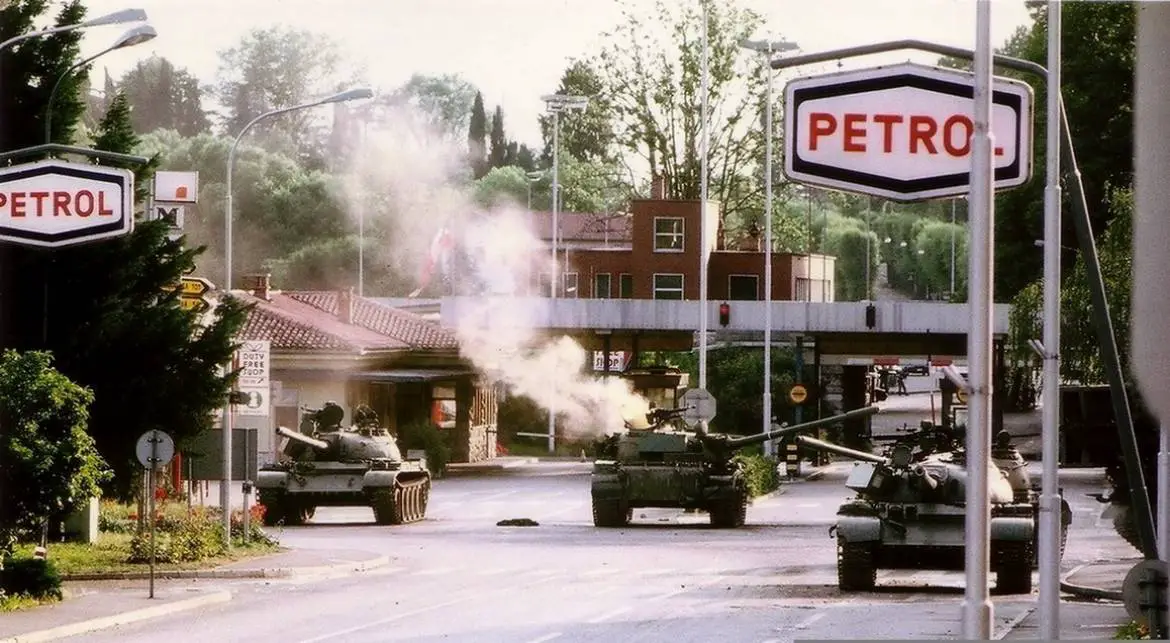 Photo: YPA tank on fire after it being hit by a Slovenian TO fired armbrust at the Rozna Dolina border crossing near Nova Gorica. Photo: YPA tank on fire after it being hit by a Slovenian TO fired armbrust at the Rozna Dolina border crossing near Nova Gorica.
 Photo: Slovene policemen and civilians leading surrendered soldiers of the YPA, Rozna Dolina border crossing near Nova Gorica. Photo: Slovene policemen and civilians leading surrendered soldiers of the YPA, Rozna Dolina border crossing near Nova Gorica.
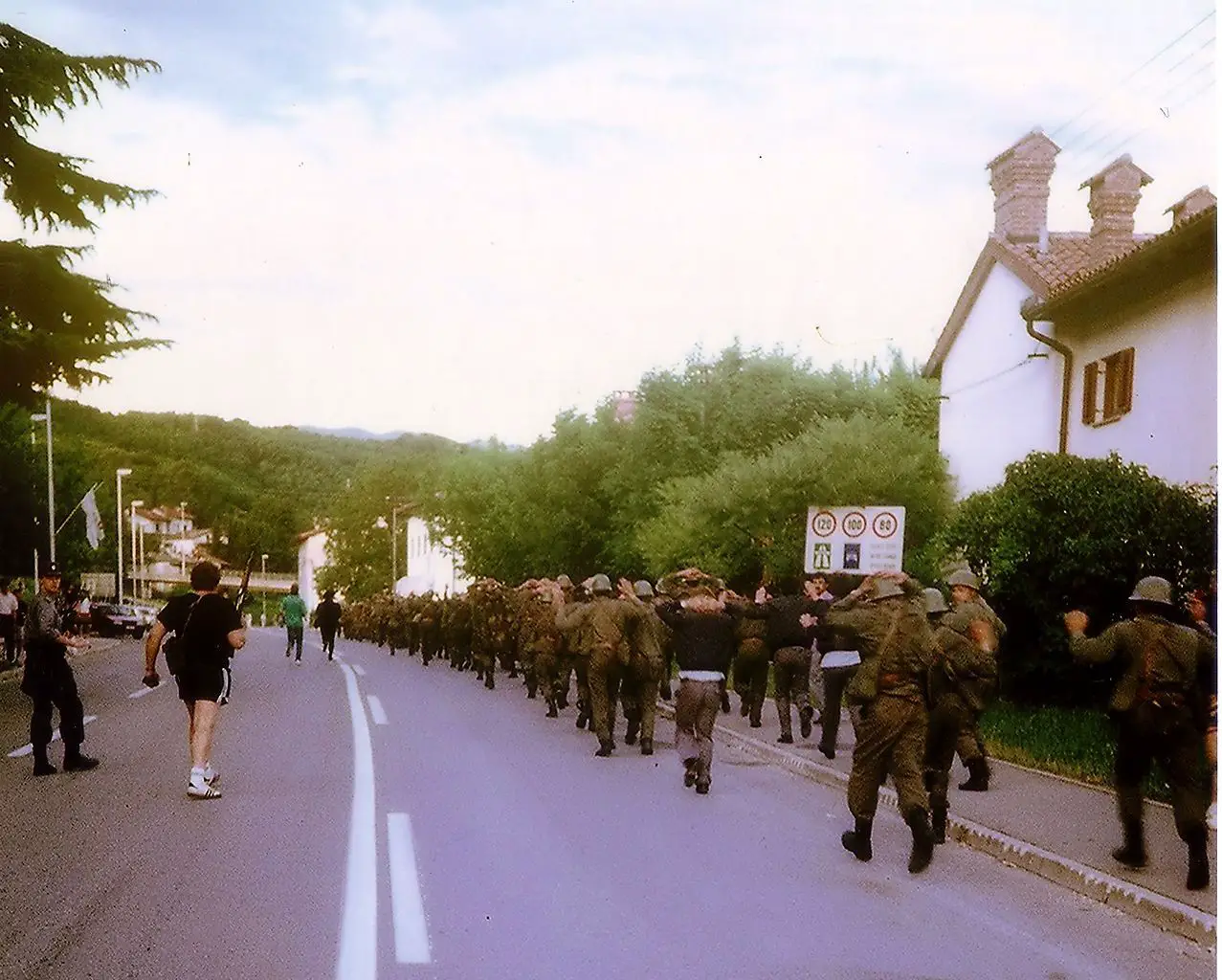 The border crossing at Holmec was captured by Slovenian TO forces. Two Slovenian and three YPA soldiers were killed, and 91 YPA soldiers captured. The YPA barracks at Bukovje Mansion in Bukovje near Dravograd were attacked by Slovenian TO units and a YPA weapons depot at Borovnica fell to the Slovenian TO, significantly improving the Slovenians' supply of weapons. The Yugoslav Air Force carried out attacks at a number of locations across the country, most notably at Brnik Airport, where two journalists from Austria and Germany (Nikolas Vogel and Norbert Werner) were killed and four Adria Airways airliners were seriously damaged. The Yugoslav Air Force also attacked the Slovenian TO military headquarters at Kočevska Reka and flew sorties against radio and television transmitters at Krim, Kum, Trdina Peak, and Nanos in an attempt to silence the Slovenian government broadcasts. By the end of the day, the YPA still held many of its positions but was rapidly losing ground. YPA was beginning to experience problems with desertions — many Slovenian members of the YPA quit their units or simply changed sides - and both the troops on the ground and the leadership in Belgrade appeared to have little idea of what to do next.
|
|
lordroel
Administrator
Posts: 67,964 
Likes: 49,369
|
Post by lordroel on Jun 29, 2019 6:40:42 GMT
Day 3 of the Slovenian Independence War, June 29th 1991
The outbreak of the war galvanised diplomatic efforts by the European Community to find an end to the crisis. Three EC foreign ministers met with Slovenian and Yugoslav government representatives in Zagreb during the night of 28–29 June and agreed on a ceasefire plan, but this was not put into practice. In the morning, the Slovenians achieved several significant military successes. The YPA troops at Ljubljana Airport near Brnik surrendered to Slovenian TO forces, who had surrounded the facility overnight. In the north, several YPA tanks were captured near Strihovec and later reorganised into a TO tank company. YPA special forces attempted a maritime landing at Hrvatini but were ambushed and repulsed by the Slovenians. The YPA-held border crossings at Vrtojba and Šentilj also fell to the Slovenian TO, who seized the federal troops' weapons and tanks, providing a much-needed boost to their arsenal. The YPA issued an ultimatum to Slovenia, demanding an immediate cessation of hostilities by 09:00 on June 30th. In response, the Slovenian Assembly adopted a resolution calling for a peaceful solution to the crisis that did not jeopardise Slovenian independence, and rejected the YPA ultimatum. Photo: Slovenian Soldier and a seized M-84 main battle tank of YPA, Vrhnika, Slovenia.
|
|
lordroel
Administrator
Posts: 67,964 
Likes: 49,369
|
Post by lordroel on Jun 30, 2019 7:23:49 GMT
Day 4 of the Slovenian Independence War, June 30th 1991
Skirmishing continued in several places during the day. Slovenian forces seized the strategic Karawanken Tunnel under the Alps on the border with Austria and captured nine YPA tanks near Nova Gorica. The entire YPA garrison at Dravograd – 16 officers and 400 men, plus equipment – surrendered, and the garrisons at Tolmin and Bovec also fell to the Slovenians. The weapons captured from the garrisons are quickly re-issued to the Slovenian forces.
|
|
stevep
Fleet admiral
Posts: 24,832 
Likes: 13,222
|
Post by stevep on Jun 30, 2019 9:42:41 GMT
Day 4 of the Slovenian Independence War, June 30th 1991
Skirmishing continued in several places during the day. Slovenian forces seized the strategic Karawanken Tunnel under the Alps on the border with Austria and captured nine YPA tanks near Nova Gorica. The entire YPA garrison at Dravograd – 16 officers and 400 men, plus equipment – surrendered, and the garrisons at Tolmin and Bovec also fell to the Slovenians. The weapons captured from the garrisons are quickly re-issued to the Slovenian forces.
I noticed that in comparison with the Slovenian document you linked to which emphasised how much the Yugoslav army was doing the attacking much of it seems to be coming from the Slovenian side against isolated YFA forces.  |
|
lordroel
Administrator
Posts: 67,964 
Likes: 49,369
|
Post by lordroel on Jun 30, 2019 9:46:18 GMT
Day 4 of the Slovenian Independence War, June 30th 1991
Skirmishing continued in several places during the day. Slovenian forces seized the strategic Karawanken Tunnel under the Alps on the border with Austria and captured nine YPA tanks near Nova Gorica. The entire YPA garrison at Dravograd – 16 officers and 400 men, plus equipment – surrendered, and the garrisons at Tolmin and Bovec also fell to the Slovenians. The weapons captured from the garrisons are quickly re-issued to the Slovenian forces. I noticed that in comparison with the Slovenian document you linked to which emphasised how much the Yugoslav army was doing the attacking much of it seems to be coming from the Slovenian side against isolated YFA forces.  I think the YPA units where send in piece meal to Slovenia and did not exactly know what their orders where. You can see that on the map that the Slovenian TO units only needed to control the border post and keep them close to prevent the YPA from doing much. |
|
stevep
Fleet admiral
Posts: 24,832 
Likes: 13,222
|
Post by stevep on Jun 30, 2019 9:53:00 GMT
I noticed that in comparison with the Slovenian document you linked to which emphasised how much the Yugoslav army was doing the attacking much of it seems to be coming from the Slovenian side against isolated YFA forces.  I think the YPA units where send in piece meal to Slovenia and did not exactly know what their orders where. You can see that on the map that the Slovenian TO units only needed to control the border post and keep them close to prevent the YPA from doing much.
Yes unlike the later conflicts with the Croats and Bosnians the regular army seems to think they just have to occupy a few areas and opposition will dissipate. They seem unprepared for any opposition and reluctant to open fire 1st. Also, possibly because there are a number of non-Serbs as well as Slovenians, detachments seem to be willing to surrender or see a lot of desertions fairly rapidly. |
|
lordroel
Administrator
Posts: 67,964 
Likes: 49,369
|
Post by lordroel on Jun 30, 2019 9:55:54 GMT
I think the YPA units where send in piece meal to Slovenia and did not exactly know what their orders where. You can see that on the map that the Slovenian TO units only needed to control the border post and keep them close to prevent the YPA from doing much. Yes unlike the later conflicts with the Croats and Bosnians the regular army seems to think they just have to occupy a few areas and opposition will dissipate. They seem unprepared for any opposition and reluctant to open fire 1st. Also, possibly because there are a number of non-Serbs as well as Slovenians, detachments seem to be willing to surrender or see a lot of desertions fairly rapidly. Yep, that is true, Slovenia was lucky that the escape the horrors what Croatia and Bosnia are going to suffer for the next couple of years. |
|
lordroel
Administrator
Posts: 67,964 
Likes: 49,369
|
Post by lordroel on Jul 1, 2019 2:44:06 GMT
Day 5 of the Slovenian Independence War, July 1st 1991
More skirmishes took place, with Slovenian TO forces taking over a YPA facility at Nova vas, south of Ljubljana. The YPA's ammunition dump at Črni Vrh caught fire and was destroyed in a massive explosion, damaging much of the town. However, the Slovenians successfully captured depots at Pečovnik, Bukovžlak, and Zaloška Gorica, taking possession of some 70 truckloads of ammunition and explosives. The YPA 306th Light Air Defence Artillery Regiment's column retreated from its exposed position at Medvedjek and headed into the Krakovo Forest (Krakovski gozd) near the Croatian border. It ran into a blockade near the town of Krško and was surrounded by Slovenian forces, but refused to surrender, probably hoping for help from a relief column. YouTube (General News Service- Slovenia And Croatia Proclaim Independence From Yugoslavia)
Photo: a BOV-3 - air-defense vehicle armed with a triple M55A4B1 20mm cannon belonging to the YPA 306th Light Air Defence Artillery Regiment near Krakovo Forest.
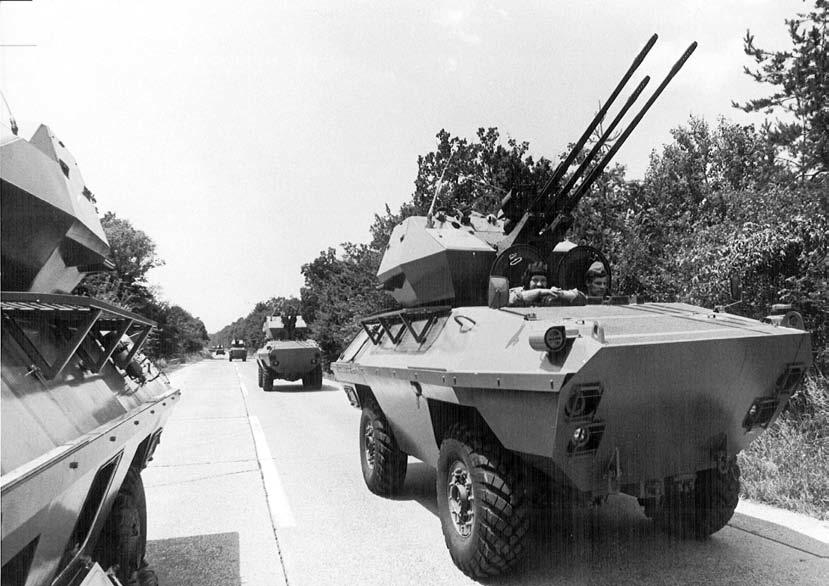 Photo: YPA anti-aircraft artillery columns are ambushed by TO forces near Krakovo Forest. Photo: YPA anti-aircraft artillery columns are ambushed by TO forces near Krakovo Forest.
 In the meantime, the YPA's leadership sought permission to change the tempo of its operations. Defence Minister Veljko Kadijević informed the Yugoslav cabinet that the YPA's first plan – a limited operation to secure Slovenia's border crossings – had failed, and that it was time to put into operation the backup plan of a full-scale invasion and imposition of military rule in Slovenia. However, the collective presidency – headed at the time by Serbia's Borisav Jović – refused to authorise such an operation. The YPA Chief of Staff, General Blagoje Adžić, was furious and publicly denounced "the federal organs [which] continually hampered us, demanding negotiations while they [the Slovenians] were attacking us with all means. Photo: from the other side in Austria, Austria soldiers moved to positions in the border area

|
|





























